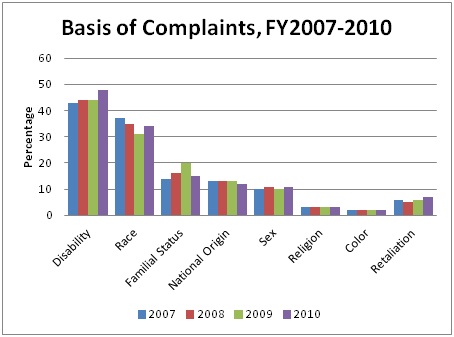
The Status of Fair Housing
The year 2010 marked a crucial milestone in the quest for fair housing. In addition to its longstanding duty to monitor specific instances of discrimination, HUD began to more proactively address the regulatory and structural frameworks that give rise to discriminatory practices.
By the Numbers: Housing Discrimination in 2010
In 2010, 10,155 housing discrimination complaints were filed with HUD and its Fair Housing Assistance Program (FHAP) partners — state and local government agencies designated by HUD to investigate Fair Housing Act complaints in their jurisdictions. This total is slightly lower than in 2009, when total complaints reached 10,242. Notably, 2010 also marks the fifth consecutive year that housing discrimination grievances exceeded 10,000.
As in previous years, the highest percentage of these complaints were filed based on disability (48%) followed by race (34%). Although the number of complaints based on disability and race used to be quite similar, the gap separating the two has widened every year since 2007. Complaints were also filed based on familial status (15%), national origin (12%), sex (11%), religion (3%), color (2%), and retaliation (7%). Of those complaints based on national origin, 7 percent were founded on housing discrimination against those with Hispanic or Latino backgrounds.

Source: U.S. Department of Housing and Urban Development, “Live Free, Annual Report on Fair Housing, FY2010,” Table 1, p. 20. Percentages do not total 100% as complaints may contain multiple bases.
Most discrimination complaints (59%) arose from discriminatory terms, conditions, privileges, services, and facilities in the rental or sale of property. That category might include a landlord who fixes a leak for a white tenant but not a black one, a landlord who demands a higher security deposit from a person in a wheelchair than from other tenants, or a building manager who will not lease or sell housing to a family with children.
Working Proactively on Structural Causes of Discrimination
HUD proactively initiated revisions that clarify and specify how programs that receive community planning and development funds can more effectively use these grants to affirmatively further fair housing (AFFH). HUD has given AFFH regulation greater emphasis in applications to its competitive grant programs, and the Department expects that the revised regulations will help groups better assess and address local fair housing issues.
HUD has also taken specific actions to better enforce fair housing initiatives already underway. For example, the city of Joliet, Illinois omitted mention of how the city would address discrimination motivated by race, color, religion, sex, disability, family status, or national origin in its consolidated plan. HUD ruled that without this planning element, the city could no longer receive Department funds. In response, Joliet embarked on a new plan that recognizes these potential impediments.
In 2010, HUD also launched fair housing initiatives in response to recent political and economic events.
- Subprime loans and fraudulent mortgage modifications. Research shows that minorities, including African Americans and Hispanics, were more likely than whites to be granted subprime mortgages, even if their credit scores and other financial characteristics were similar, which has resulted in higher foreclosure rates in minority neighborhoods. Today, this type of discrimination has taken on a new form: fraudulent offers of mortgage assistance targeting African Americans and Hispanics. To address this discrimination, HUD partnered with the Lawyers’ Committee for Civil Rights Under Law to forge the Loan Modification Scam Prevention Network. In addition to educating homeowners about scams, the network links consumers with free mortgage counseling from HUD-approved groups and aims to increase the reporting of fraud.
- Housing and undocumented immigrants. In response to recent legislation in Arizona, Nebraska, and elsewhere, targeting undocumented immigrants, HUD has initiated a number of investigations to determine whether the legislation may be linked to increased housing discrimination based on Latino or Hispanic origin. For example, S.B. 1075, passed in Arizona in April 2010, specifies that residents may not “harbor” undocumented immigrants. In response, the Office of Fair Housing and Equal Opportunity joined with the state’s Attorney General to publish an opinion explaining that the normative landlord/tenant relationship is not the same as “harboring” an undocumented immigrant.
You can read Live Free: Annual Report on Fair Housing, FY 2010, here.
PD&R Leadership Message Archive
International & Philanthropic Spotlight Archive
Spotlight on PD&R Data Archive
Publications
Collecting, Analyzing, and Publicizing Data on Housing Turnover
Resilience Planning: What Communities Can Do to Keep Hazards from Turning into Disasters
Cityscape: Volume 26, Number 3
Case Studies
Case Study: Former School in Charleston, South Carolina, Transformed into Affordable Housing for Seniors
Case Study: Avalon Villas Combines Affordable Housing and Services for Families in a Gentrifying Phoenix Neighborhood

The contents of this article are the views of the author(s) and do not necessarily reflect the views or policies of the U.S. Department of Housing and Urban Development or the U.S. Government.
Note: Guidance documents, except when based on statutory or regulatory authority or law, do not have the force and effect of law and are not meant to bind the public in any way. Guidance documents are intended only to provide clarity to the public regarding existing requirements under the law or agency policies.



